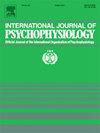Synergistic prioritization in memory: Electrophysiological evidence for metamemory-driven automatic and strategic mechanisms
IF 2.6
3区 心理学
Q3 NEUROSCIENCES
引用次数: 0
Abstract
Adaptively prioritizing high-value information is crucial for maximizing memory efficiency. Although recent research has demonstrated that prioritization in value-directed remembering relies on automatic and strategic mechanisms, it is controversial whether these mechanisms operate independently or synergistically to enhance memory selectivity. In particular, the neural correlations of how the underlying metamemory regulates these processes remain unclear. Thirty healthy adults completed an adapted value-directed remembering paradigm in which metamemory was manipulated through pre-encoding cues indicating the upcoming test form (recognition/free recall/unknown). During the encoding phase, participants studied high- and low-value words, and event-related potentials (ERPs) and time-frequency activity were recorded to examine the roles of automatic and strategic mechanisms, which was followed by a cued recall test. The results revealed that metamemory modulated resource allocation via N400 and frontal slow wave amplitudes and strategic selection through alpha- and theta-band time-frequency activity, collectively influencing the strategic mechanism. Specifically, time-frequency activity in the theta band related to the suppression of low-value items was more strongly correlated with memory selectivity than was time-frequency activity in the alpha band related to the selection of high-value items. The automatic mechanism indexed by the P2 amplitude is dynamically adapted to engage with the strategic mechanism. These findings provide the first neurophysiological evidence for metamemory-driven synergy between automatic and strategic mechanisms, validating responsible remembering theory. Crucially, our results challenge the traditional view of selective enhancement as dominant, instead highlighting the critical role of inhibition in priority encoding.
记忆中的协同优先化:元记忆驱动的自动和策略机制的电生理证据
自适应地确定高价值信息的优先级对于最大化内存效率至关重要。虽然最近的研究表明,价值导向记忆的优先次序依赖于自动和策略机制,但这些机制是独立运作还是协同运作以提高记忆选择性仍存在争议。特别是,潜在的元记忆如何调节这些过程的神经相关性仍然不清楚。30名健康成人完成了适应性价值导向记忆范式,在该范式中,元记忆通过提示即将到来的测试形式(识别/自由回忆/未知)的预编码线索来操纵。在编码阶段,被试研究了高值词和低值词,并记录了事件相关电位(ERPs)和时间频率活动,以检验自动机制和策略机制的作用,随后进行了线索回忆测试。结果表明,元记忆通过N400调节资源分配,通过额叶慢波振幅调节资源分配,通过α和θ波段时频活动调节策略选择,共同影响策略机制。具体而言,与抑制低价值项目相关的θ波段时频活动与记忆选择性的相关性比与选择高价值项目相关的α波段时频活动更强。以P2振幅为索引的自动机制动态适应于与战略机制的接触。这些发现为元记忆驱动的自动机制和策略机制之间的协同作用提供了第一个神经生理学证据,验证了负责任记忆理论。至关重要的是,我们的结果挑战了选择性增强占主导地位的传统观点,而是强调了抑制在优先编码中的关键作用。
本文章由计算机程序翻译,如有差异,请以英文原文为准。
求助全文
约1分钟内获得全文
求助全文
来源期刊
CiteScore
5.40
自引率
10.00%
发文量
177
审稿时长
3-8 weeks
期刊介绍:
The International Journal of Psychophysiology is the official journal of the International Organization of Psychophysiology, and provides a respected forum for the publication of high quality original contributions on all aspects of psychophysiology. The journal is interdisciplinary and aims to integrate the neurosciences and behavioral sciences. Empirical, theoretical, and review articles are encouraged in the following areas:
• Cerebral psychophysiology: including functional brain mapping and neuroimaging with Event-Related Potentials (ERPs), Positron Emission Tomography (PET), Functional Magnetic Resonance Imaging (fMRI) and Electroencephalographic studies.
• Autonomic functions: including bilateral electrodermal activity, pupillometry and blood volume changes.
• Cardiovascular Psychophysiology:including studies of blood pressure, cardiac functioning and respiration.
• Somatic psychophysiology: including muscle activity, eye movements and eye blinks.

 求助内容:
求助内容: 应助结果提醒方式:
应助结果提醒方式:


